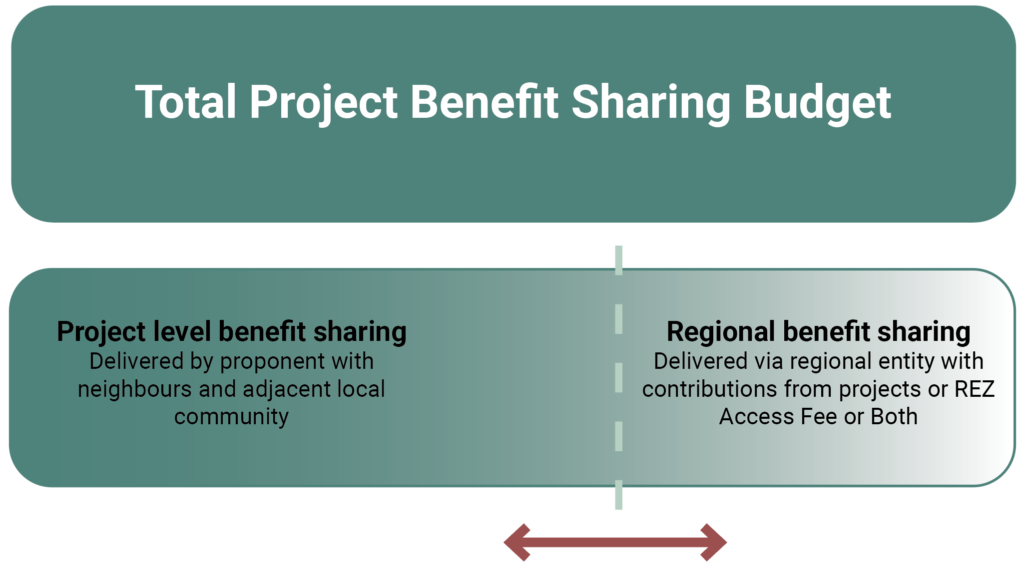Read our discussion paper: Regional Benefit Sharing – Creating strategic impacts for regions that host multiple renewable energy projects
Australia’s changing from fossil fuels to renewable energy isn’t just a technological shift, but also a spatial shift. As states ramp up renewable energy deployment, there has been an influx of infrastructure proposals in regional communities, most notably for those in state-designated ‘renewable energy zones’ (REZs).
Community benefit sharing 101
Amid the energy shift, community benefit sharing (CBS) has emerged as a crucial strategy to support regions hosting new renewable energy infrastructure. CBS involves sharing the benefits of renewable energy projects with the communities hosting them. The aim is to integrate these projects into local communities, contributing to their long-term vitality and success of the region.
Community benefit sharing typically involves financial support for community benefit programs, reaching not only immediate neighbours but also nearby towns and villages. These benefits can take various forms, including grants, partnerships, scholarships, or opportunities for community co-ownership. Crucially, the community plays a role in deciding what the benefits should be as without genuine community engagement, project proponents run the risk of CBS being perceived as an attempt to “buy out” or “bribe” the community.
Why regional coordination of benefit sharing is needed
While Australia’s renewable energy sector has made strides in individual project-level benefit sharing, the challenge now is to efficiently and thoughtfully deliver multiple projects within designated regions. To maximise benefits and minimise adverse impacts, strategic planning is essential. Regions, governments, and industry must coordinate benefit sharing programs to empower communities and avoid duplicating efforts.
Regional benefit sharing is defined as the strategic aggregation of community benefit sharing programs associated with energy projects that are located in a common geographic region. Whilst a current working model has not yet emerged in Australia there are 6 key reasons why it should:
- Reducing engagement fatigue: Streamlining local engagement avoids overburdening communities and ensures effective solutions both in the set up and ongoing management of programs.
- Changing community expectations: Evolving community expectations demand informed involvement and strategic outcomes from energy projects that address local concerns.
- Diminishing small community projects to fund: Small community grant programs run out of suitable projects over time, limiting their impact. Coordination enables larger, more impactful initiatives.
- Big picture legacy: Pooled funding can tackle long-term challenges, like climate resilience, public health issues and the shift in our energy system.
- Leverage: Pooled funding opens doors to larger grants and funding streams.
- Expanding Reach: Coordinated benefit sharing offers innovative ways to distribute benefits, reaching disadvantaged communities.
Watch our webinar on Regional Benefit Sharing featuring a presentation by CPA authors Kim Mallee and Dr Jarra Hicks, followed by insights and Q&A with fellow leading experts: Lisa Lumsden, The Next Economy; Kate Hook, RE-Alliance; and Luke Osborne, Stride Renewables.
How does regional benefit sharing work?
Typically a developer of an energy infrastructure project will allocate funds towards community benefit sharing within a certain geographic area that hosts the project. When done well the community co-designs the benefit sharing program and its reach with the developer. This could create a positive impact for direct neighbours, nearby towns and villages or even the region at large. This practice has been fit for purpose where there has been only one of very few projects in a single region.
Regional benefit sharing works to coordinate multiple projects benefit sharing efforts at the neighbourhood and local community level whilst also pool and enable benefit sharing initiatives at a regional level. It is critical that regional benefit sharing models do not supersede or inhibit a project’s ability to deliver benefit sharing programs at the neighbourhood and local level and build trusted relationships with the host community. The split of funds between local or regional benefit sharing programs can be flexible over time and designed with the host community.

Clarification Needed on Local Government Contributions
Victoria is the first jurisdiction to have a formalised statewide and consistent approach to calculating and collecting infrastructure contributions to Council from renewable energy developments. For remaining jurisdictions this is a lost opportunity to ensure that the economic prosperity and development in a local government area also contributes to the ongoing renewal of public infrastructure and services of that area.
NSW Councils for example, have the opportunity to negotiate voluntary planning agreements with developers when they are assessed as Major Projects. However this has led to varying outcomes ranging from receiving nothing to Councils receiving all of the potential community benefit sharing funds in place of the funds going directly to community. This scenario can inadvertently pit Council against the community in negotiations with the developer in the middle. The Victorian model of Payment in Lieu of Rates should be explored for delivery in other states as the number of projects and quantity of community benefit sharing funds per project are testament to its viability.
Key recommendations
Community Power Agency has been at the forefront of understanding and developing better practice community benefit sharing, through authoring multiple community benefit sharing guides delivering industry training, and working in Northern Tasmania, Gippsland in Victoria, and New England NSW REZ regions. We have compiled our insights into the Regional Benefit Sharing discussion paper which synthesises CBS experiences and models and provides key recommendations for government and industry stakeholders.
Strategic coordination is essential for benefit sharing to cultivate a social licence, a crucial component in achieving a fair and fast energy shift in regions hosting multiple energy infrastructure projects.
Community Power Agency recommends:
- All state governments co-design with communities regional benefit sharing programs, ensuring local community members are embedded in the governance structures.
- Regional benefit sharing models are designed in a way that enables energy project developers to deliver both regional benefits as well as neighbourhood and local benefit sharing programs.
- If REZ Access Fees are charged, they serve as a safety net or coordination of benefit sharing, rather than a substitute for individual project level benefit sharing initiatives.
- Federal Government dedicates resources to the various entities involved in designing regional benefit sharing in order to contribute to nation-wide social licence for the energy shift.
- State governments legislate the amount project proponents must contribute to the local government where their project is located, in lieu of rates or as infrastructure contributions. This payment should be separate and additional to the project’s community benefit sharing funds.
